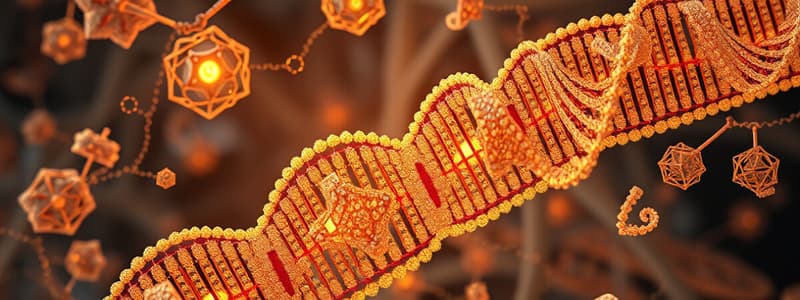Podcast
Questions and Answers
What does hnRNA (pre-mRNA) stand for?
What does hnRNA (pre-mRNA) stand for?
- Homogeneous nuclear RNA
- Heterogeneous nuclear RNA (correct)
- Highly nuclear RNA
- None of the above
What is the role of RNA processing?
What is the role of RNA processing?
Modification of mRNA before it leaves the nucleus.
The overall events for processing hnRNA to mRNA include adding a 5' cap and a 3' ______ sequence.
The overall events for processing hnRNA to mRNA include adding a 5' cap and a 3' ______ sequence.
Poly(A) tail
What is a 5' cap?
What is a 5' cap?
What is the purpose of the 3' Poly(A) sequence?
What is the purpose of the 3' Poly(A) sequence?
What is snRNA?
What is snRNA?
What initiates the sequential phosphorylation of the RNA Pol II CTD?
What initiates the sequential phosphorylation of the RNA Pol II CTD?
What happens when serine-7 is mutated to alanine?
What happens when serine-7 is mutated to alanine?
What is the primary function of CDK9?
What is the primary function of CDK9?
What is the function of Flavopiridol?
What is the function of Flavopiridol?
What does P-TEFb stand for?
What does P-TEFb stand for?
Without ATP, the P-TEFb kinase enzyme fails to phosphorylate the Serine amino acid residue in position ______.
Without ATP, the P-TEFb kinase enzyme fails to phosphorylate the Serine amino acid residue in position ______.
What is the effect of inhibiting CDK9?
What is the effect of inhibiting CDK9?
Flashcards are hidden until you start studying
Study Notes
hnRNA (pre-mRNA)
- Heterogeneous nuclear RNA is the primary transcript in eukaryotes before splicing.
RNA Processing
- This refers to the modifications of mRNA necessary before it exits the nucleus; exclusive to eukaryotic cells.
Processing of hnRNA to mRNA
- hnRNA undergoes processing involving adding a 5' cap, a 3' Poly(A) tail, and splicing to remove introns.
- The splicing mechanism entails breaking the exon-intron junctions and joining exons, resulting in mature mRNA.
- Mature mRNA is subsequently transported through nuclear pores for translation in the cytoplasm.
5' Cap
- A modified guanine nucleotide added to the 5' end of pre-mRNA.
- It protects mRNA from degradation and facilitates ribosome binding during translation.
3' Poly(A) Sequence
- A poly(A) tail at the 3' end safeguards mRNA from enzymatic degradation and aids in transcription termination, export from the nucleus, and translation.
snRNA (small nuclear RNA)
- Small RNA molecules (~200 nucleotides) that participate in splicing by removing introns.
Sequential Phosphorylation of RNA Pol II CTD Heptapeptide Tail
- Step I: Serine 5 is phosphorylated by TFIIH kinase, signaling for 5'-Capping factors.
- Step II: Serine 2 is phosphorylated by P-TEFb kinase, promoting recruitment of intron splicing factors.
- Step III: Dephosphorylation of Ser 5 by PPase leads to increased Ser 2 phosphorylation and recruitment of polyadenylation factors.
Serine 7
- Phosphorylation of Ser-7 occurs prior to transcription initiation by CDK7.
- Necessary for the recognition of RT-PCR by P-TEFb kinase for splicing factor recruitment.
- Mutations in Ser-7 can hinder snRNA gene expression.
RNA Polymerase II CTD Structure and Function
- The CTD consists of heptapeptide repeats, featuring seven amino acid sequences.
- Each heptad includes "Serine" at positions 2, 5, and 7, which are phosphorylated sequentially by specific kinases, recruiting factors for hnRNA processing.
Eukaryotic Transcription Elongation and Anticancer Drug Targeting
- P-TEFb is a kinase crucial for phosphorylating Ser 2 of the RNA polymerase II CTD, aiding in intron splicing factor recruitment.
- It plays a role in potential anticancer drug development.
Flavopiridol (P-TEFb Kinase Inhibitor) - Mechanism
- Inhibits P-TEFb by blocking ATP-binding, preventing phosphorylation of Ser 2 on RNA Pol II CTD.
- This disruption halts hnRNA processing, thereby blocking mRNA production and protein synthesis, leading to cancer cell apoptosis.
Alvocidib (CDK9 Inhibitor)
- A potent inhibitor of CDK9, which activates transcription elongation via phosphorylation of RNA polymerase II CTD.
- By inhibiting CDK9, alvocidib reduces transcription of key target genes, including MCL-1, impacting cancer cell survival.
Studying That Suits You
Use AI to generate personalized quizzes and flashcards to suit your learning preferences.



